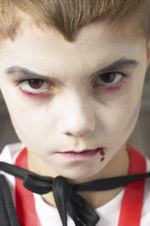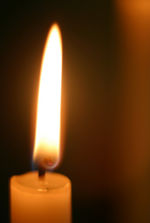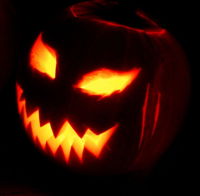|
Halloween, as we know it today, has taken root in a host of other countries; and each has it's own Halloween traditions, some of which are listed here:
| The Barmbrack Cake
|
| Similar to the Mardi Gras tradition of the King Cake, the traditional Halloween Cake in Ireland is the Barmbrack Cake - a fruitcake with a piece of rag, a coin and a ring in each cake. If you get the rag, then your financial future is doubtful. If you get the coin, then you can look forward to a prosperous year. Getting the ring is a sure sign of impending romance or continued happiness. [2] .
|
    Ireland Still significant for the Irish today, Halloween continues to be a time of dress up, bonfires and bobbing for apples. Spectacular fireworks displays can be seen on Halloween and throughout the entire month of October. Houses there are adorned with carved turnips that are sometimes lit with candles from within for an eerie glow like the American jack-o-lanterns. A traditional lunchtime meal of Colcannon (potatoes and kale/cabbage) is often served. Some in Ireland refer to Halloween as "Pooky Night". It's said that trick-or-treating began when Celtic children would go from house to house gathering fruit, nuts and sweets for the Samhain Night festival. Irish children continue this form of trick-or-treating, now asking for candy in addition to the traditional fare.[3]
Great Britain / UK - In Northern Britain, Mischief Night typically falls on October 30th when children play an assortment of tricks on unsuspecting adults. On November 5th, 1605, Guy Fawkes was caught trying to blow up the English Parliament. That evening, people lit bonfires and set off fireworks to celebrate Fawkes'capture. In January 1606, the English Parliament made November 5th a day of national thanksgiving. Since then, Guy Fawkes Day has been a huge celebration in England. Some people think of Guy Fawkes Day as England's Halloween.[4] The American "trick or treating" custom, together with the donning of costumes for going door-to-door, has become a relatively popular pasttime among English children at Halloween, although many of the adults (particularly the older generations) have little idea as to why they are being asked for sweets and are usually ill-prepared to accommodate their small and hopeful callers.[5]
Mexico - The Mexican people have celebrated Halloween since the early 1960s[6]. Although they use the American Halloween themes such as dressing in costume and asking for candy, they do not generally play "tricks" if someone does not provide candy. Halloween continues into "Los Dias de los Muertos", The Days of the Dead, which are celebrated during All Saints' Day and All Souls' Day on November 1-2.
Romania - Halloween in Romania is celebrated around the myth of "Dracula". There, in what was known as Transylvania, and especially in the city of Sighişoara, there are many costume parties. Modern folklore and a dark reputation ties the 15th century Romanian prince, Vlad III, - known for impaling his enemies - to the fictional vampire, Count Dracula. The legend of the vampire was and still is deeply rooted in that region. Witch trials swept through the area during the 18th century, and these trials are recreated today by actors on the night of Halloween.
Sweden - In Sweden, All Hallows Eve (Alla Helgons Natt) is a Christian, public holiday which always falls on the first Saturday in November. This holiday bears little to no resemblance to the American Halloween; rather it involves lighting candles at the graves of loved ones, and remembering the dead. This type of observance is also the case in countries like in Austria, Belgium and other western European countries. It is not uncommon to leave bread, water and a lighted lamp or candle on the table before retiring on Halloween night which stems from an old belief that these items would welcome dead souls back to earth.
Czechoslovakia - In Czechoslovakia, chairs are placed by the fireside on Halloween night. There is one chair for each living family member and one for each family member's spirit.
Germany - In Germany, many citizens put away their knives on Halloween night. This traditional practice was long ago put into place as a means to avoid harm befalling the returning spirits.
Related Pages
References
- ↑ wikipedia.org - Halloween
- ↑ Ireland-Information.com - Irish Halloween Traditions
- ↑ GoIreland.com - Halloween in Ireland
- ↑ worldalmanacforkids.com - Trick or Treat! The Story of Halloween
- ↑ Novareinna.com - Halloween Around the World
- ↑ Wikipedia - Halloween Around the World
|








 Printer Friendly
Printer Friendly
